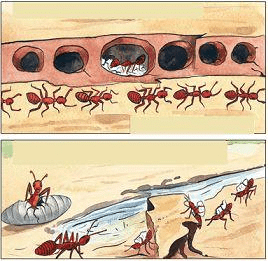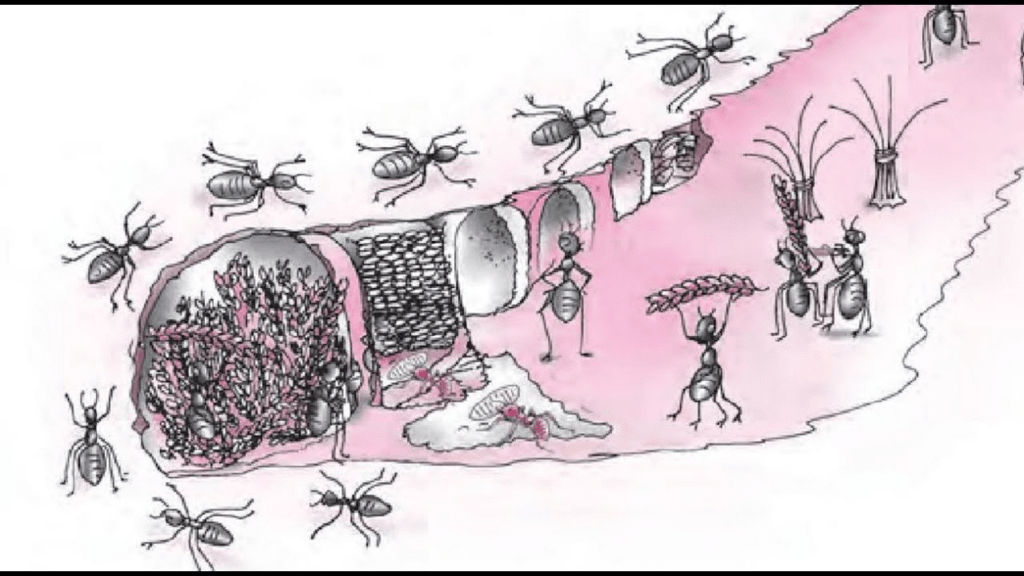NCERT Solutions for Class 7 English - The Tiny Teacher
The tiny teacher is a story that teaches us about the tiniest teacher we can learn from. It tells us about the ant who can be a great teacher if we look closely.

Ants are small but very hardworking
Let's have a look at the NCERT Solutions of The Tiny Teacher
Comprehension Check (Page 3)
Q1. The story of an ant's life sounds almost untrue.
The italicized phrase means
(i) highly exaggerated.
(ii) too remarkable to be true.
(iii) not based on facts.
Correct Answer is Option (I) highly exaggerated
Q2. Complete the following sentences.
(i) An ant is the smallest, ___________________________
Ans: An ant is the smallest, the commonest and the wisest insect we have seen.
(ii) We know a number of facts about an ant's life because ____________________________
Ans: We know a number of facts about an ant's life because people have kept ants as pets and have watched their daily behaviour closely.
Q3. In what ways is an ant's life peaceful?
- The queen ant has a pair of wings, which she casts off before she begins to lay eggs.
- Eggs hatch and become grubs, grubs change into cocoons, and cocoons break to bring forth complete ants.
- The life of an ordinary ant in the anthill is a book which many of us seldom open.
Ans: An ant's life is peaceful because each ant does its share of work intelligently and bravely, and never fights with other members of the group.
Comprehension Check (page 5)
The queen is the mother of the entire population of the colony. It lives for about fifteen years. It has a pair of wings, but bites them off after its ‘wedding’ flight. This flight takes place on a hot summer day. The queen leaves the nest and goes out to meet a male ant, or drone, high up in the air. On its return to earth, it gets rid of its wings and then does nothing but lay eggs. Eggs hatch and grubs come out. Soldiers guard them. Workers feed and clean them, and also carry them about daily for airing, exercise and sunshine. Two or three weeks later, grubs become cocoons and lie without food or activity for three weeks more. Then the cocoons break and perfect ants appear. Now it’s time for teaching and training. New ants learn their duties from old ants as workers, soldiers, builders, cleaners, etc. After a few weeks’ training, the small ants are ready to go out into the big world of work. An anthill is a home not only for ants but also for some other creatures—beetles, lesser breeds of ants and the greenfly. Why do ants want these alien creatures to live in their nests? For several reasons: some give off smell pleasant to the ants’ senses; others give sweet juices; and some are just pets or playthings like cats and dogs to human beings. The greenfly is the ants’ cow. The ants train it to give honeydew (like milk) with a touch of their antennae. They milk it just as we milk the cow. Have humans learned as much as ants have? Perhaps they have, but they haven’t put their learning to good use. They may still learn a few things from this tiny teacher— hard work, sense of duty and discipline, cleanliness, care for the young ones, and, above all, a firm loyalty to the land where they live.
Q1. How long does it take for a grub to become a complete ant?
Ans: After two or three weeks, a grub becomes a cocoon. After another three weeks, the cocoon breaks and a complete ant appears.
Q2. Why do the worker ants carry the grubs about?
Ans: The worker ants carry the grubs about daily for airing, exercise, and sunshine.
Q3. What jobs are new ants trained for?
Ans: The new ants are trained as workers, soldiers, builders, cleaners, etc.
Q4. Name some other creatures that live in anthills.
Ans: Some other creatures that live in anthills are beetles, lesser breeds of ants, and the greenfly.
Q5. Mention three things we can learn from the 'tiny teacher'. Give reasons for choosing these items.
Ans: Three things we can learn from the 'tiny teacher' are sense of duty and discipline, cleanliness and loyalty to the land where they live. These are the qualities that most humans lack.

Exercises
Discuss the following topics in groups.
Q1. (i) What problems are you likely to face if you keep ants as pets?
(ii) When a group of bees finds nectar, it informs other bees of its location, quantity, etc. through dancing. Can you guess what ants communicate to their fellow ants by touching one another’s feelers?
Ans: (i) There might be several problems if we keep ants as pets. They spoil food and eatables. They bite. They won’t listen to our orders.
(ii) Ants communicate about food newly found by them to their fellow ants by touching one another’s feelers.
Q2. Complete the following poem with words from the box below. Then recite the poem.
Soldiers live in barracks
And birds in ______,
Much like a snake that rests
In a ______. No horse is able
To sleep except in a ______.
And a dog lives well,
Mind you, only in a ______.
To say 'hi' to an ant, if you will,
You may have to climb an ______.
| Hole, Kennel, Nests, anthill, stable |
Ans:
Soldiers live in barracks
And birds in nests,
Much like a snake that rests
In a hole. No horse is able
To sleep except in a stable.
And a dog lives well,
Mind you, only in a kennel.
To say 'hi' to an ant, if you will,
You may have to climb an anthill.
|
7 videos|128 docs|40 tests
|
FAQs on NCERT Solutions for Class 7 English - The Tiny Teacher
| 1. Who is the protagonist of the story "The Tiny Teacher"? |  |
| 2. What is the central theme of the story "The Tiny Teacher"? |  |
| 3. How does the tiny ant teach the narrator a valuable lesson? |  |
| 4. What lesson does the narrator learn from observing the tiny ant? |  |
| 5. How does the story "The Tiny Teacher" emphasize the idea of learning from nature? |  |























